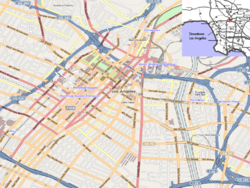Bunker Hill, Los Angeles
| Bunker Hill | |
|---|---|
| Neighborhood of Los Angeles | |

Bunker Hill as seen from Los Angeles City Hall
|
|
| Location within Downtown Los Angeles | |
| Coordinates: 34°03′07″N 118°15′01″W / 34.052035°N 118.250347°W | |
| Country | United States |
| State | California |
| County | County of Los Angeles |
| City | Los Angeles |
| Area code(s) | 213 |
Bunker Hill is a historic prominence that traditionally separated Downtown Los Angeles from the rest of the city to the west before the hill was tunneled through at Second Street in 1924.
In the late 20th century, the hill was lowered in elevation, and the entire area was redeveloped to supplant old frame and concrete buildings with modern high-rises and other structures for residences, commerce, entertainment and education. The Cathedral of Our Lady of the Angels is also on Bunker Hill.
In 1867, a wealthy developer, Prudent Beaudry, purchased a majority of the hill's land. Because of the hill's excellent views of the Los Angeles Basin and the Los Angeles River, he knew that it would make for an opulent subdivision. He developed the peak of Bunker Hill with lavish two-story Victorian houses that became famous as homes for the upper-class residents of Los Angeles. Angels Flight, now dubbed "The World's Shortest Railway", took residents homeward from the bottom of the 33% grade and down again.
Initially a residential suburb, Bunker Hill retained its exclusive character through the end of World War I, but in the face of increased urban growth fed by an extensive streetcar system, its wealthy residents began leaving for enclaves on the Westside and Pasadena. Bunker Hill's houses were increasingly sub-divided to accommodate renters. Still, Bunker Hill was at this time "Los Angeles's most crowded and urban neighborhood". By World War II the Pasadena Freeway, built to bring shoppers downtown, was taking more residents out. Additional post-war freeway construction left downtown comparatively empty of both people and services. The once-grand Victorian mansions of Bunker Hill became the home of impoverished pensioners.
In 1955, Los Angeles city planners decided that Bunker Hill required a massive slum clearance project. The top of Bunker Hill was cleared of its houses and then flattened as the first stage of the Bunker Hill Redevelopment Project to populate Bunker Hill with modern plazas and buildings. When the height limit of buildings for Los Angeles was finally raised (previously buildings were limited to 150 feet), developers built some of the tallest skyscrapers in the region to take advantage of the area's existing dense zoning. In approving such projects, the city sought to project a modern, sophisticated image.
...
Wikipedia

